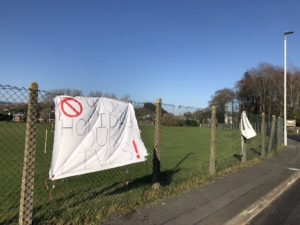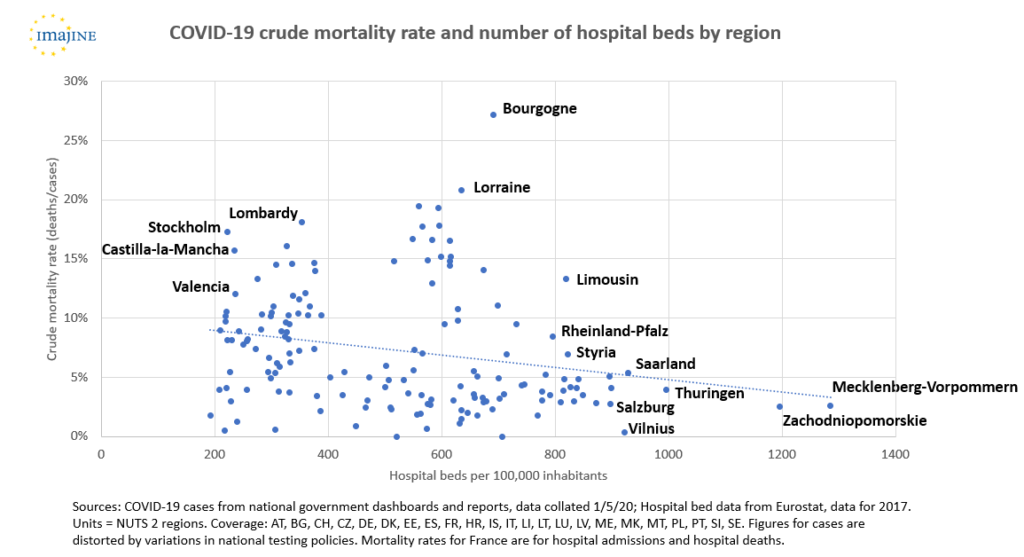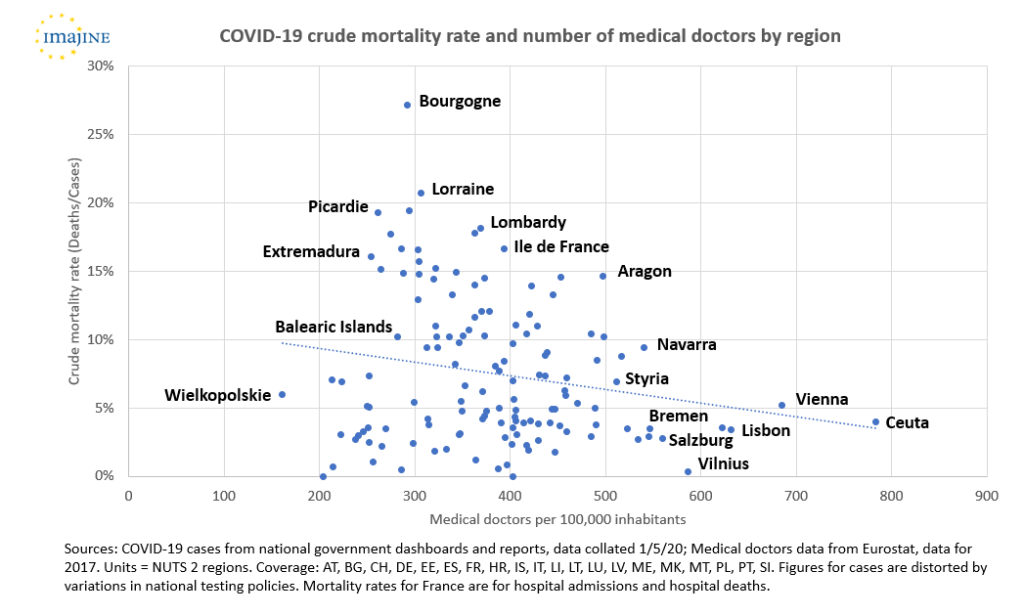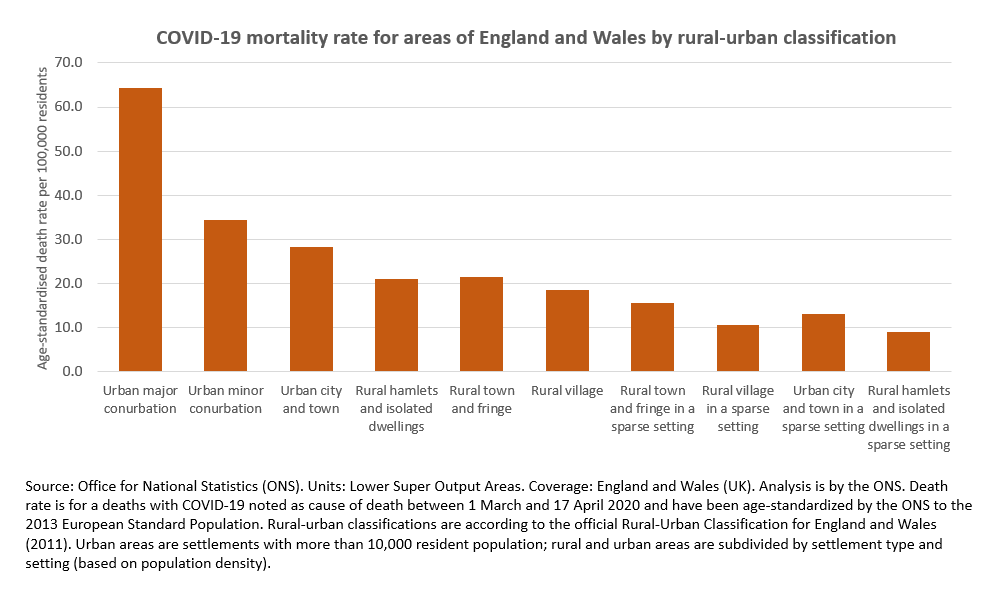In the first part of this two-part blog post, I introduced some of the ways in which the IMAJINE team are considering how our research might contribute towards understanding and responding to the COVID-19 outbreak and its impacts, and discussed initial analysis of the spatial patterns of the outbreak in Europe and possible relations with existing territorial inequalities. In this second part of the post, I focus on the questions of spatial justice that are raised by responses to the outbreak and which have bearing on how we recover from the crisis and how we plan for future pandemics, as well on the lessons that we might be able to draw from our IMAJINE research.
Spatial Justice in the time of COVID-19
In IMAJINE we have been studying territorial inequalities through the theoretical framework of spatial justice, or the way in which power imbalances and social disparities are played out over space. There are a number of different ways of approaching spatial justice, several of which are relevant to examining the geographical inequalities of the COVID-19 crisis.
Firstly, spatial justice can be employed to interrogate the uneven distribution of resources by the state and how this shapes the quality of life and opportunities of people living in different places. This is the sense in which spatial justice has been developed as a concept in urban geography and sociology, by writers such as Ed Soja, to explore how socio-economic divisions within cities have been systematically produced and reproduced. In the first post of this duo, I discussed how initial analysis indicates that the impact of COVID-19 is differentiated by territorial inequalities, with higher mortality rates in more socio-economically deprived districts, and observed that contributing factors might include variations in public service infrastructure.
One of the most obvious potential factors is access to high quality healthcare. Appropriate data for analysing relationships between healthcare provision and COVID-19 mortalities at sub-national scales is patchy (with notable gaps for Belgium, the Netherlands and the UK), and available figures for crude mortality rates (deaths relative to cases) are affected by differences in testing policy and reporting procedures. Nonetheless, simple scatterplots with available data for NUTS 2 regions in Europe show modest but clear trendlines that suggest that COVID-19 mortality rates decrease with increasing numbers of hospital beds per 100,000 population, and with increasing numbers of medical doctors per 100,000 population in a region. These trends are tentative, subject to influence by other factors, and require further investigation, but resonate with reports linking inequalities in access to healthcare to spatial variations in COVID-19 deaths within Paris and with a concentration of cases in north east Romania. Indeed, there have been suggestions that the response in parts of eastern Europe has been complicated by shortages of medical staff due to migration to western Europe, sometimes disguised by relatively high figures for the ratio of hospital beds to people as a consequence of depopulation, but that awareness of limitations helped to prompt early and decisive government action.
In many parts of Europe, regional disparities in healthcare have been accentuated over the last decade by austerity policies that have promoted the centralization of services and informed decisions on new investments, upgrading facilities and staffing levels. It is not only in health that austerity has had spatially uneven impacts, creating or reinforcing structural inequalities between regions in sectors such as social care and in the resources of local government. The rolling-back of welfare has had greater consequences for people in some communities than in others, morphing into geographical disparities in the severity of the COVID-19 outbreak as individuals in precarious positions have been put at greater risk of contracting the coronavirus by a necessity to continue going to work or by inadequate living conditions.
Urban planning policies similarly have entrenched structural inequalities, protecting green space in rural and suburb settings whilst surrendering urban green spaces for development, privatising public spaces, designing high density housing complexes, and eroding community support networks as long-term residents are displaced by gentrification. None of these policies are intended to produce health inequalities, but in reflecting value judgements about the targeting of public resources and the service levels and environmental conditions that are tolerable in areas populated by different social classes and ethnic groups, they have indirectly loaded the chances of individuals from different districts and backgrounds contracting and surviving the coronavirus.
The second perspective on spatial justice extends some of the above concerns by focusing on the right to space, or the rights of individuals to live in and use certain spaces equally. The issue of access to green space in the COVID-19 crisis exemplifies this. The notion of ‘white collar quarantine’ mentioned in the first post not only captures differentiated capacities to work from home between occupations, but also the qualitative difference between wealthier residents isolating in large houses with gardens and nearby green space and low-income families confined to one or two-room flats in densely packed neighbourhoods with limited public space. The latter circumstances not only make social distancing whilst exercising more difficult to maintain, and may tempt individuals to breach lockdown restrictions putting themselves at greater risk of infection, but also increase risks to residents from secondary physical and mental health effects and from domestic violence.
As such, the right to space has become a contentious issue during the COVID-19 crisis, with disputes over the over-crowding of public spaces, temporary closures of parks, and restrictions on access to privately-owned land. In London, there have been unheeded calls for golf courses and the playing fields of private schools to be opened for public exercise to relieve pressures on public parks.
Similar tensions have developed around access to the countryside. Demographic-based modelling, for example by St Andrews University, projects that rural areas should be disproportionately affected by COVID-19 due to their older populations, and reports have highlighted the vulnerability of rural communities in the United States. Yet, the COVID-19 outbreak in Europe has been primarily urban in focus (with some notable exceptions). Analysis by the British Office for National Statistics, for instance, has calculated age-standardized mortality rates from COVID-19 in England and Wales up to the 17th April to be just 9.0 deaths per 100,000 people in hamlets and isolated dwellings in sparsely-populated rural areas compared with 64.3 deaths per 100,000 people in major conurbations. A blog post by a senior medical officer in rural Wales attributes this difference to low population density, or what he labels natural ‘rural distancing’, which was initially projected to slow the spread of the coronavirus into rural areas but which in conjunction with lockdown controls may have helped to effectively suppress the virus in some rural areas altogether. However, incidences in rural areas could spike if lockdown restrictions are lifted too early.
Accordingly, rural residents in Britain, Ireland and elsewhere have been vigilant in policing mobility during the crisis. An especially virulent campaign in Wales was prompted by large numbers of day-trippers who visited rural tourism sites over weekend immediately prior to the start of the UK lockdown in mid-March, and has seen particular ire directed at moving second homes or holiday homes to isolate themselves, evoking deeper-rooted politics around the right to rural housing, as IMAJINE researcher Bryonny Goodwin-Hawkins has discussed in an article for The Conversation.
Photograph by Michael Woods

Photograph by Bryonny Goodwin-Hawkins
Warnings in rural Wales for visitors to stay away during the COVID-19 outbreak
Rural sensitivities are grounded in concerns about a more elderly population and more limited local healthcare provision. As such, they are an expression of claims to spatial justice articulated as a defence of local interests against external threats. Yet, from a different spatial justice perspective they raise questions about the right to the countryside: why permanent residents are considered to have greater rights to live in rural communities during the COVID-19 lockdown than seasonal residents; why members of rural households returning from studying or working in cities are not perceived as a threat in the same way as an urban couple quarantining in an isolated holiday cottage; and what are the consequences of blocking access to expansive rural land for pressures on urban parks and associated heightened risks of coronavirus transmission. Some of these implications of the coronavirus for rural-urban relations have been discussed at greater length by IMAJINE researcher Bettina Bock and colleague Jessica Duncan in a blog post.
These questions also connect to the third way of viewing spatial justice, which is whether residents perceive their region to have been treated fairly. The extensive spread of COVID-19 and uniform introduction of lockdown measures within countries appears to have larger suppressed public perceptions of unfair treatment in the early stages of the outbreak, however discontent could potentially increase as the crisis continues and more comparisons are made between regions. Ideas of pan-European solidarity have already been tested, with accusations that other EU countries were slow to come to the aid of Italy as the pandemic unfolded and, particularly, anger at the reluctance of some Eurozone states to back measures to support the Italian economy. As part of the IMAJINE research we will be conducting a survey of citizens in seven European countries to explore perceptions of territorial inequalities, spatial justice and inter-regional solidarity. This survey has been postponed until the autumn and will now include questions specifically to examine the effects of COVID-19 on public attitudes.
The easing of lockdown restrictions is likely to spark disputes over the fair treatment of regions, especially if controls are lifted in some regions but maintained in others. This could trigger reactions from both directions: from those who consider that their civil liberties are being unfairly limited by continuing lockdowns, or that businesses are disadvantaged by spatially differentiated measures, but also from those fearful that restrictions have been relaxed too early in their region. Suggestions in the UK that the lockdown could be ended first in the Western Isles of Scotland – the only district of Britain to record no COVID-19 related deaths up to the end of April – have been met with a strongly negative local response; whilst in Wales there have been calls for more local control of lockdown decision-making to protect rural areas. As such, the dilemma of spatial justice in the lifting of lockdowns involves questions about the management of the COVID-19 crisis in multi-level governance systems.
Multi-level Governance and Public Health
There are two schools of thought as to the structures of governance that best reflect principles of spatial justice. One approach argues for a strong central authority to redistribute wealth between regions and check the inherent protectionism of affluent districts. The other places emphasis on the distribution of power as much as on economic inequalities, promoting decentralisation with cities and regions making their own decisions. In practice, European states tend to strike a balance between these models, with multi-level governance systems in which different responsibilities are assigned to local, regional, national and European tiers. An inevitable consequence is territorial inequality: policy divergence between devolved authorities will lead to different outcomes, including in health. A strand of IMAJINE has been analysing the role of multi-level governance in non-epidemic health inequalities, and we are looking to expand this work to examine the implementation of the COVID-19 response across and between different levels of national and regional governance.
The potential for tensions within multi-governance systems have been most vividly illustrated in the United States, where the White House has squabbled with State governors over powers, lockdown measures and resources. There have been reports of US states and federal government competing over purchases of medical instruments and personal protection equipment (PPE) and of federal support being directed to states on a partisan basis. Tensions in Europe have been less dramatic and high-profile, but have nonetheless emerged in a number of countries. In Germany, where powers relevant to lockdown measures largely lie with Lander, the federal government has reportedly struggled to assert a coordinated approach against efforts from states including Bremen and Hamburg to unilaterally ease restrictions. In the UK, reports have indicated disquiet at apparent lack of consultation by the UK government of devolved administrations in Scotland and Wales over easing the lockdown, with suggestions that the territories could follow different routes.
A survey in Germany found that citizens in almost all regions thought that the federal government should lead on the COVID-19 response – with exception of Bavaria, which maybe indicates that views on leadership in the coronavirus crisis are shaped by existing territorial politics and perceptions of spatial justice. The question will be repeated in our IMAJINE multi-national survey. The tendency of people to look to national governments in times of crisis is perhaps also supported by opinion polls that have shown big increases in the approval ratings of incumbent national political leaders in most European states. Yet, the observed pattern of governments treating COVID-19 as a national emergency was not necessarily a given in a pandemic that is at once both global and local. Indeed, a leading public health professor in Britain has argued for a more localised approach, critiquing the UK government for bypassing local government and highlighting the consequences of erosions in local health authority capacities. These issues over who should lead is relevant not only to the management of the outbreak, but also to the management of the economic recovery.
Challenges for Economic Recovery
The long-term consequences of the COVID-19 pandemic on territorial inequalities in Europe will follow not only from the effects of the coronavirus outbreak itself, but also from restrictions on economic activity in responses measures, and from the management of the re-opening and recovery. Robust, comprehensive data for the economic impact of the crisis on indicators such as GDP at the regional scale will not be available until long after the passing of the outbreak (and indeed after the end of the IMAJINE project). However, there are lessons that might be drawn from the analysis that we have undertaken in IMAJINE of the long-term evolution of territorial inequalities in Europe over the last three decades, including the impact of the last Europe-wide shock: the Global Financial Crisis in 2008.
One lesson is that the COVID-19 crisis is likely to widen territorial inequalities in the European economy, just as the Global Financial Crisis did. Prior to the Global Financial Crisis (GFC), the economies of regions in the European Union had been converging, with the key measure of the regional dispersion of GDP between NUTS 3 regions decreasing between 2000 and 2007. Between 2007 and 2013, however, the regional dispersion of GDP increased in 16 out of 26 EU countries with available data, as more affluent regions rebounded faster and more strongly than economically lagging regions. Both our IMAJINE analysis and that of other studies have found that in Greece and Italy, where the recession sparked by the GFC was intensified by domestic fiscal crises, significant variations in the regional impact could be attributed to the sectoral composition of the economy in different regions, degrees of connectedness with the rest of Europe, and local welfare regimes.
In spite of its apparent pervasiveness, the COVID-19 crisis is likely to have a similarly differentiated regional economic impact, with some regions more badly affected than others, thus reinforcing existing territorial inequalities but also creating some new fissures of inequality. The regions that will record the most severe economic effects are not necessarily the regions that were most deprived before the crisis, nor are they necessarily the same as the regions with the highest incidences of coronavirus cases. Restrictions on travel and workplaces and disruption to supply chains affect different industries variably, with data collected by the Office for National Statistics in the UK showing that the accommodation, food service and arts, entertainment and recreation sectors have experienced most business shut-downs, whilst construction, retail, transportation, manufacturing and administrative services industries have also been hit by substantial drops in turnover. As these economic sectors are geographically clustered, so the local impacts of the shutdown will vary, with analysis by KPMG suggesting that COVID-19 will redraw the regional economic map of the UK. Its analysis projects more substantial impacts, measured for example by falls in GVA, in local authorities with disproportionate employment in transportation, automotive industries, construction and tourism worst affected, especially in the West Midlands and North West of England. London, peripheral rural areas and districts with higher public sector employment are forecast to be less severely impacted. A similar exercise by the Brookings Institute in the USA pinpointed the most vulnerable localities as including mining towns, cities with large leisure sectors such as Las Vegas, and tourism destinations such as the Gulf Coast.
Tourism in particular has been flagged as a major economic casualty in Europe. Income from tourism in Italy has been forecast to fall by €20 billion this year compared with 2019, with 25 million fewer foreign visitors expected over the summer. In Britain, data for bank card transactions collated by the news website Tortoise over the Easter period found that the largest drops in usage compared with last year tended to be in smaller towns in tourist areas of south west England and Wales. A reduction in tourism revenues in Spain of 77% in March has reportedly been reflected in the emphasis in Spain’s recovery strategy on re-starting manufacturing industry, in order to compensate for the collapse of tourism, which normally contributes around 15% of national GDP. Yet, this thinking fails to address the problem that industrial districts are not the same as tourist regions.
It is not only the mix of economic sectors that affects the resilience of regional economies to COVID-19 and the shutdown. Districts with higher levels of self-employment, more small businesses and greater numbers of people dependent on the gig economy are likely to be worse affected due to the disproportionate precarity of components of the economy, even with unprecedented business support packages. These characteristics are often typical of rural districts, which when combined with the significance of tourism in many rural economies underpins assessments that rural areas may be especially impacted by the economic consequences of the coronavirus, even if most COVID-19 cases are concentrated in urban areas.
The most detailed preliminary analysis of the regional economic impacts of COVID-19 policy responses in the EU currently available, published by Spatial Foresight last week, further reinforces both the significance and the complexity of the emerging pattern. Its modelling identifies metropolitan and industrial regions including Catalonia, Lombardy, Madrid and Paris as among the most severely impacted territories, but also rural and tourism-oriented areas in Germany, Italy, southern Ireland, Estonia, Czechia and Crete; yet, its parallel very provisional assessment of potential economic beneficiaries of COVID-19 policy responses shows these largely concentrated on capital cities and generally more prosperous regions such as Bavaria, Lombardy and South Holland.
As such, forecasts of the economic impact of COVID-19 aren’t necessarily consistent in identifying the most vulnerable localities, but they do agree that the impact will be spatially uneven, and that targeted measures to help the worst affected districts recover will be needed.
In January 2021, the European Union will commence a new seven-year programme for its Structural Funds – the primary mechanism through which the EU supports regional development and seeks to address territorial inequalities and build cohesion. The initial stages of the new programme will now be dominated by the post-COVID-19 recovery, presenting challenges for its ability to adapt to a rapidly shifting environment with only partial data available. Previous Structural Funds programmes had distributed funding between NUTS 2 regions according to the simple measure of GDP per capita relative to the EU average. In IMAJINE we have critiqued this methodology as both too narrow in its focus on GDP to reflect the diverse dynamics of inequalities as experienced by individuals, and too broad it is framing at the NUTS2 scale to accurately target localised spatial inequalities. Significantly, the European Commission has already modified its approach for the new programme, introducing additional criteria for the geographical distribution of funds including youth employment, education level, climate change and the reception and integration of immigrants, and affording a greater role for local and territorial authorities in the management of regional programmes. These changes will help EU Cohesion Policy to respond to the impacts of COVID-19, but may not be enough. Consideration may need to be given to incorporating further indicators that can support specific targeted actions in the worst affected localities, especially if these can be sourced from data with relatively quick turn-arounds, such as data on unemployment claims or business closures.
It is not only the delivery mechanisms for regional development programmes that might require adjustment, but also the aims and content of programmes. The underlying assumption of EU Cohesion policy that convergence is best achieved through economic growth in lagging regions allowing them to catch up might be found to be out of kilter with public attitudes in a post-COVID-19 world. Already, a group of Dutch academics has attracted attention with proposals for the recovery to be based on principles of de-growth, whilst a case for returning to basics has been made by the Foundational Economy Collective. Mayors in Spain have similarly called for social justice and investment in public services to be at the heart of recovery planning and a global network of city leaders has issued a statement of principles emphasizing greater equality and climate resilience. Spatial justice in this new context may mean not equalising economic performance between regions on conventional measures, but strengthening the resilience of localities and regions to withstand shocks.
The final part of the IMAJINE project will provide us with the opportunity to explore whether and how public views have changed as we conduct participatory scenario-building exercises with stakeholders in several regions across Europe early next year. Although planned long before the coronavirus outbreak and designed to debate alternative regional futures the exercises will provide a perfect platform for reflecting on regional experiences of COVID-19 and their influence on people’s perceptions of inequality, resilience and spatial justice, and testing public openness to potentially radical pathways for the future. They will provide a fascinating insight into how far the world really has changed.
As outlined in these two posts, the COVID-19 outbreak and its socio-economic consequences saturate our areas of concern in the IMAJINE project with territorial inequalities and spatial justice. The crisis has both been shaped by and will contribute to territorial inequalities, as well as raising questions of spatial justices and challenges for multi-level governance and for the economic recovery. With the pandemic in Europe tragically continuing it is too early for us to make any definitive conclusions, but questions raised in these posts are ones that we will return to with further research and analysis over the coming months and will update with further blogs and briefing notes on this website.
Michael Woods (Aberystwyth University)
This research has received funding from the European Union’s Horizon 2020 research and innovation programme under grant agreement No 726950. This blog post reflects only the author’s view. The Commission is not responsible for any use that may be made of the information it contains.





